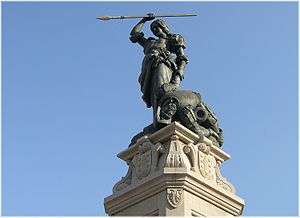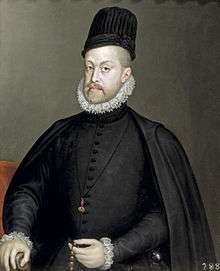English Armada
The English Armada, also known as the Counter Armada or the Drake-Norris Expedition, was an attack fleet sent against Spain by Queen Elizabeth I of England in 1589, during the undeclared Anglo-Spanish War (1585–1604) and the Eighty Years' War. It was led by Sir Francis Drake as admiral and Sir John Norreys as general, and failed to drive home the advantage England had won upon the failure of the Spanish Armada in the previous year.[1] The Spanish victory marked a revival of Philip II's naval power through the next decade.[1]
Background
After the failure of the Spanish Armada, Queen Elizabeth I's intentions were to capitalise upon Spain's temporary weakness at sea and to compel Philip II to sue for peace. The expedition had three objectives: to burn the Spanish Atlantic fleet (that was being repaired in ports of northern Spain), to make a landing at Lisbon and raise a revolt there against Philip II (Philip I of Portugal), and then to continue west and establish a permanent base in the Azores. A further aim was to seize the Spanish treasure fleet as it returned from America to Cádiz, although this depended largely on the success of the Azores campaign.

The strategic objective of the military expedition was to break the trade embargo imposed across the Portuguese empire, which included Brazil and the East Indies, among other areas, and trading posts in India and China. By securing an alliance with the Portuguese crown, Elizabeth hoped to curb Spanish Habsburg power in Europe and to free up the trade routes to these possessions. This was a difficult proposition, because Philip had been accepted as king by the aristocracy and clergy of Portugal in 1581 at the Cortes of Tomar. The pretender to the throne, António, Prior of Crato — the last surviving heir of the House of Aviz — failed to establish an effective government in exile in the Azores, and turned to the English for support. He was not a charismatic figure, and with his cause compromised by his illegitimacy, he faced an opponent with a relatively strong claim to the throne in the eyes of the Portuguese nobles of the Cortes, Duchess Catherine of Braganza.
The complex politics were not the only obstacle for the enterprise. Like its Spanish predecessor, the English expedition suffered from unduly optimistic planning, based on hopes of repeating Drake's successful raid on Cadiz in 1587. There was a contradiction between the separate plans, each of which was ambitious in its own right, but the most pressing need was the destruction of the Spanish Atlantic fleet lying at port in Corunna, San Sebastián and Santander along the northern coast of Spain, as directly ordered by the Queen.
The expedition was floated as a joint stock company, with capital of about £80,000 — one quarter to come from the Queen, and one eighth from the Dutch, the balance to be made up by various noblemen, merchants and guilds. The treasurer was Sir James Hales (died 1589), who died on the return journey, as is recorded on his monument in Canterbury Cathedral. Concerns over logistics and adverse weather delayed the departure of the fleet, and confusion grew as it waited in port. The Dutch failed to supply their promised warships, a third of the victuals had already been consumed, and the number of veteran soldiers was only 1,800 while the ranks of volunteers had increased the planned contingent of troops from 10,000 to 19,000. Unlike the Spanish Armada expedition of the previous year, the English fleet also lacked siege guns and cavalry, which could compromise its intended aims.
Execution
When the fleet sailed it was made up of six royal galleons, 60 English armed merchantmen, 60 Dutch flyboats and about 20 pinnaces. In addition to the troops, there were 4,000 sailors and 1,500 officers and gentlemen adventurers. Drake assigned his vessels to five squadrons, led respectively by himself in the Revenge, Sir John Norreys in the Nonpareil, Norreys' brother Edward in the Foresight, Thomas Fenner in the Dreadnought, and Roger Williams in the Swiftsure. Also sailing with them — against the Queen's express orders — was the Earl of Essex.
Most of the ships lost in Philip II's expedition of 1588 had been armed merchantmen, while the core of the Armada — the galleons of the Squadron of Portugal of the Armada del Mar Oceano (Atlantic Fleet) — survived their voyage home and docked in Spain's Atlantic ports for a refit, where they lay for months, vulnerable to attack.
Coruña
Unforeseen delays, many of them related to Drake's own fear of becoming embayed in the Bay of Biscay, led Drake to bypass Santander, where most of this refitting was under way. He alleged unfavourable winds and turned to attack Corunna (Coruña) in Galicia. It is not fully clear why, but he may have been motivated by a false contemporary legend that a tower in Corunna held a fabulous treasure of gold coins, or he may have just been looking for supplies.
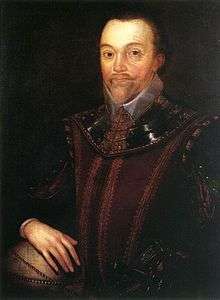
Corunna was almost defenceless at the time of the attack. To face the English Armada's 150 ships plus boats, and the soldiers in them, Corunna had one galleon (San Juan, with 50 cannons), two galleys (Diana and Princesa, with 20 cannons each), and two other smaller ships (nao San Bartolomé with 20 cannons, and the unarmed urca Sansón and galeoncete (small galleon) San Bernardo). A combination of militia, hidalgos and the few available soldiers totalled 1,500 soldiers, most of them with little military training, except for seven companies of old tercios who happened to be resting in the city after their return from war. It also had the medieval city walls, built in the 13th century.[11]
Norreys took the lower town, inflicted 500 casualties, and plundered the wine cellars there, while Drake destroyed thirteen merchant ships in the harbour. For the next two weeks the wind blew westerly, and while waiting for a change the English occupied themselves in a siege of Corunna's fortified upper town. They launched three major assaults against the walls of the upper town, and tried to breach them with mines, but the vigorous defence by the regular Spanish troops, militia, and women of the city including Maria Pita and Inés de Ben[12] forced the English back with severe losses.[11](2018: pp.77–97)
The Princesa and the Diana managed to avoid capture and slip past the English fleet repeatedly to resupply the defenders. After 14 days of siege and attempted assaults, on the 18th, the English heard news about Spanish reinforcements on their way to Corunna, and at length, with a favourable wind returning and painfully low morale, the English abandoned the siege and retreated to their ships, having lost four captains, three large ships,[13] various boats[13] and more than 1,500 men in the fighting alone, along with 3,000 other personnel in 24 of the transports. This included many of the Dutch who found reasons to return to England or put into La Rochelle.[11](2018: pp.77–97)
The next step in Elizabeth's plan was to stir a Portuguese uprising against King Philip. The Portuguese aristocracy had recognised him as King of Portugal in 1580, adding the Kingdom of Portugal to the Hispanic Monarchy. The pretender to the throne that England supported, the Prior of Crato, was not an ideal candidate. He did not have enough support even to establish a government in exile, nor much charisma to back his already dubious claim. Elizabeth had agreed to help him in hopes of diminishing the power of the Spanish Empire in Europe, and in exchange for a permanent military base in the strategic Azores Islands from which to attack merchant ships and ultimately obtain control of the commercial routes to the New World.
Portugal
On May 6, Drake arrived at Peniche, in Portugal, which was handed to them by supporters of Crato. After that, they headed towards Lisbon, 11,000 men and 110 ships at this point. Owing partially to poor organisation and lack of coordination (they had very few siege guns) the invading force failed to take Lisbon from the garrison of 7,000 Portuguese and Spanish soldiers and 40 ships guarding it. The expected uprising by the Portuguese loyal to Crato never materialised.[14](pp.204–214)
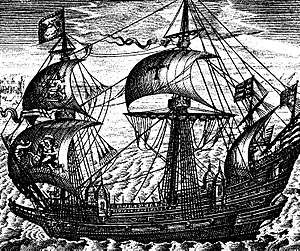
Lisbon was rumoured to be guarded by a disaffected garrison, but whilst the English were fruitlessly besieging Corunna, the Spanish had spent a fortnight shoring up Portugal's military defences. When Norreys invaded Lisbon, the expected uprising was not forthcoming and little was achieved. Drake did take the opportunity on 30 June of seizing a fleet of 20 French and 60 Hanseatic ships which had broken the English blockade on trade with Spain by sailing all around the north of Scotland, only to fetch up before the English cannon in the mouth of the Tagus. This seizure, notes R. B. Wernham, "dealt a useful blow to Spanish preparations",[14](p.204) but later required a publicly printed justification, a Declaration of Causes, from the Queen's own printer, as, without booty, she and her fellow English investors faced considerable losses.
The English dealt a further blow to Spanish naval preparations and food supplies by destroying the Lisbon granaries but, despite the bravado of Essex, who thrust a sword in at the gates of the city with a challenge to the defenders, the English could not take the city without artillery. Neither did they receive substantial support from the Portuguese.[14](p.214, pp.210–11) The expected uprising failed to occur, in part because of the absence of Drake, the land and naval forces having divided and being out of contact after the landing at Peniche, and the defenders would not risk battle.[14](pp.210–11)
Essex received orders from Elizabeth to return to court, along with a refusal to send reinforcements or a siege train, the queen having no desire to carry the main burden of a land war in Portugal. It was therefore decided to concentrate on the third aim of the expedition: the establishment of a permanent military base in the Azores. However, by this point the campaign had taken its toll. Drake's forces had initially caught the Spanish authorities off guard, but Spain had now marshalled her defences, and the English expedition's strength was wearing down, and suffering increasingly from disease. Two armed merchantmen were caught off Lisbon by nine Spanish galleys, commanded by Alonso de Bazán. One of them, the William, was saved by Revenge after being abandoned by her crew, but the ship did not have enough manpower aboard to sail away after the battle and had to be scuttled to prevent her falling into the hands of the Spanish again. The other vessel was engulfed in flames after a fight, and sunk, her commander Captain Minshaw being lost with the ship. Further damage was sustained when one of three boats carrying William's complement was lost with all hands after being attacked by the Spanish warships.[15]
With the attack on the Azores becoming out of the question, Drake made a final attempt to retrieve the mission. At this point, most of his men were out of action, with only 2,000 still fit to be mustered. Stormy weather had also damaged a number of the ships. While Norreys sailed for home with the sick and wounded, Drake took his pick of what was left and set out with 20 ships to hunt for the Spanish treasure fleet. While lying in wait for it his naval force was struck by another heavy storm which left him unable to continue, and while raiding and plundering Porto Santo in Madeira in compensation his flagship the Revenge sprang a leak due to storm damage and almost foundered as she led the remainder of the fleet home to Plymouth.
Aftermath
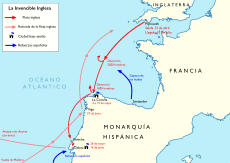
The English fleet lost about 40 ships, plus the 18 launches destroyed or captured at Corunna and Lisbon. Fourteen of the ships were lost directly to the actions of Spanish naval forces: three at Corunna; six were lost to actions led by Padilla, three to Bazán and two to Aramburu. The rest were lost to a stormy sea as the fleet made its return voyage to England. The outbreak of disease on board the vessels was also transmitted to the port town populations in England on its return. None of the campaign's aims had been accomplished, and for a number of years this expedition's results discouraged further joint-stock adventures on such a scale.[14]( p.214)[16] The English expeditionary force had sustained a heavy loss of ships, troops and resources, but only brought back 150 captured cannon and £30,000 of plunder, and had not inflicted decisive damage on the Spanish forces. Another indirect minor strategic benefit was, perhaps, a temporary disruption to Spanish military shipping activity, and the diversion of Spanish imperial resources that might have contributed to a mutiny by troops under the command of Parma in Flanders that August.
The most detailed account (in English), written in the form of a letter by an anonymous participant, was published in 1589: A true Coppie of a Discourse written by a Gentleman, employed in the late Voyage of Spain and Portingale... which set out openly to restore the credit of the participants. However, this English narrative has been shown to have been a highly effective means to bury the magnitude of the disaster.[11](2018: p.224)
With the opportunity to strike a decisive blow against the weakened Spanish navy lost, the failure of the expedition depleted the financial resources of England's treasury, which had been carefully restored during the long reign of Elizabeth I. The war was financially costly to both of its protagonists, and the Spanish Empire—which was fighting France and the United Provinces at the same time—would be compelled in financial distress to default on its debt repayments in 1596 following another raid by the English on Cadiz. Two more armadas in 1596 and 1597 were sent by Spain against England, but both were scattered by storms en route.[17] Peace was finally agreed between the two powers at the signing of the Treaty of London in 1604.
See also
References
- Notes
- Citations
- Elliott (2002) p.333
- Morris, Terence Alan (1998). Europe and England in the sixteenth century. Routledge, p.335. ISBN 0-415-15041-8
- Elliott p.333
-

- Rowse, A. L. (1969). Tudor Cornwall: portrait of a society. C. Scribner, p.400
- "One decisive action might have forced Philip II to the negotiating table and avoided fourteen years of continuing warfare. Instead the King was able to use the brief respite to rebuild his naval forces and by the end of 1589 Spain once again had an Atlantic fleet strong enough to escort the American treasure ships home." The Mariner's Mirror, Volumes 76–77. Society for Nautical Research, 1990
- Oliveira Martins (1972) História de Portugal p.442
- Bucholz, Key (2009) p.145
- Hampden (1972) p.254
- Fernández Duro (1972) p.51
- Gorrochategui Santos (2011+2018)
- Valcarcel, Isabel. Mujeres De Armas Tomar (Women-At-Arms). Madrid: Algaba, 2004.
- Rodríguez González, Agustín Ramón (2006).Victorias por mar de los españoles. Madrid: Biblioteca de Historia, Grafite Ediciones
- Wernham (1951b)
- Cummins, John (1997).Francis Drake: Lives of a Hero. Palgrave Macmillan, p. 217 ISBN 0312163657
- Wagner (2002) p.242
- Tenace (2003)
Bibliography
- R. O. Bucholz, Newton Key Early modern England 1485–1714: a narrative history (John Wiley and Sons, 2009). ISBN 978-1-4051-6275-3
- J. H. Elliott La Europa dividida (1559–1598) (Editorial Critica, 2002). ISBN 978-84-8432-669-4
- Fernández Duro, Cesáreo (1972). Armada Española desde la Unión de los Reinos de Castilla y Aragón. Museo Naval de Madrid, Instituto de Historia y Cultura Naval, Tomo III, Capítulo III. Madrid.
- Luis Gorrochategui Santos, The English Armada: The greatest naval disaster in English history (Oxford & London: Bloomsbury Publishing, 2011 + 2018) author's website
- Winston Graham The Spanish Armadas (reprint, 2001) pp. 166ff. ISBN 0-14-139020-4
- John Hampden Francis Drake, privateer: contemporary narratives and documents (Taylor & Francis, 1972). ISBN 978-0-8173-5703-0
- Mattingly, Garrett, The Armada (Mariner Books, New York 2005). ISBN 0-618-56591-4
- Parker, Geoffrey (1996). "The Dreadnought Revolution of Tudor England". The Mariner's Mirror. 82: 269–300. doi:10.1080/00253359.1996.10656603.
- J. H. Parry, 'Colonial Development and International Rivalries Outside Europe, 1: America', in R. B. Wernham (ed.), The New Cambridge Modern History, Vol. III: 'The Counter-Reformation and Price Revolution 1559–1610' (Cambridge: Cambridge University Press, 1971): 507–31.
- Helmut Pemsel, Atlas of Naval Warfare: An Atlas and Chronology of Conflict at Sea from Earliest Times to the Present Day, translated by D. G. Smith (London: Arms and Armour Press, 1977).
- Tenace, E. (2003), 'A Strategy of Reactions: The Armadas of 1596 and 1597 and the Spanish Struggle for European Hegemony'. English Historical Review, 118, pp.855-882
- John A. Wagner, Historical Dictionary of the Elizabethan World: Britain, Ireland, Europe, and America (New York: Checkmark Books, 2002).
- R. B. Wernham (1951a), "Queen Elizabeth and the Portugal Expedition of 1589: Part I" The English Historical Review 66.258 (January 1951), pp. 1–26
- R. B. Wernham (1951b), "Part II" The English Historical Review 66.259 (April 1951), pp. 194–218. Wernham's articles are based on his work editing Calendar State Papers Foreign: eliz. xxiii (January–June 1589).
- R. B. Wernham (1971) (ed.) see above, Parry (1971)
External links
- The Year After the Armada, and other historical studies, Martin Andrew Sharp Hume (New York 1896)
- Library of Congress: Hans P. Kraus, "Sir Francis Drake: A Pictorial Biography": "The Beginning of the End: The Drake-Norris Expedition, 1589" From the Rare Book and Special Collections Division at the Library of Congress
